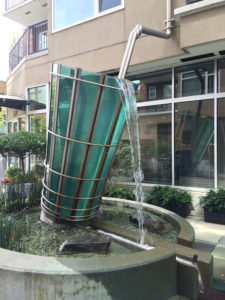The Art of Stormwater Management (Incredible! Beguiling! Beautiful!)

Welcome to some certifiable artistic creativity–with positive environmental impact. The work of Seattle sculpture Buster Simpson is an eye-opener, to pick one adjective! (His curriculum vitae, here.)
Back in 2009, Simpson gave a lecture titled: “Poetic Utilities: Artists Re-Imagine Water Infrastructure.” His work reminds me of Claes Oldenburg–except with different appropriation of ideas and purpose.
Walking along 1st Ave. in the Belltown neighborhood of Seattle last week, we passed the Ellington Condominiums at 2801. But because my eye had caught something in the entry plaza, I backpedaled. What? Initially, it was a diagonal form that seemed out of place because it was neither horizontal nor vertical. Next realized is that it was a pipe coming off the wall of the building like an unhinged downspout. For what purpose?
Dick, meet Buster Simpson whose work “Water Table / Water Glass” was commissioned by the City of Seattle some 15 years ago and is in the Collection of the City of Seattle Office of Arts & Culture.
As to the amateur hour, here’s my first attempt at creating a YouTube video and publishing it here for you. I wish I could return to Seattle anyway (perhaps to see our older daughter playing for the Emerald City Mudhens women’s rugby team or just another visit), but for more thoughtfully composing this video story. I didn’t think ’til later to blog about it.
Here’s how Simpson describes this piece-
 “Water Table / Water Glass” … exemplifies how art can work on a number of meaningful levels. As sculpture, Water Table / Water Glass provide a domestic tableau. As metaphor, Water Table / Water Glass are two elements, which create utilitarian fountains; the glass becomes a vessel, a cistern, and a detention tank; the table expresses the philosophical approach for the plaza’s landscape irrigation water table system as well as a usable table when dry. Both sculptures join to nurture the wetlands landscape. Two ten-story towers’ roof watershed provides rainwater for the two sculptures at plaza level: Water Glass from the south tower and Water Table from the north tower. The rainwater enters large baroque scuppers at the roofline and is directed through watertight stainless steel downspouts on the exterior of the two buildings.
“Water Table / Water Glass” … exemplifies how art can work on a number of meaningful levels. As sculpture, Water Table / Water Glass provide a domestic tableau. As metaphor, Water Table / Water Glass are two elements, which create utilitarian fountains; the glass becomes a vessel, a cistern, and a detention tank; the table expresses the philosophical approach for the plaza’s landscape irrigation water table system as well as a usable table when dry. Both sculptures join to nurture the wetlands landscape. Two ten-story towers’ roof watershed provides rainwater for the two sculptures at plaza level: Water Glass from the south tower and Water Table from the north tower. The rainwater enters large baroque scuppers at the roofline and is directed through watertight stainless steel downspouts on the exterior of the two buildings.
“Seven tensioning rings around Water Glass exterior serve the same structural purpose as those found on large wooden water tanks. The downspouts to Water Glass transfer their offering into a 5-inch diameter flexible “hospital” straw that empties into the 8-foot high tapered vessel. The vessel is cantilevered, gesturing an offering of its contents to the landscape. The shape of the glass is reminiscent of a pint beer glass or tall latte cup. The structure is made of stainless steel with twelve two-ply laminated glass panels; each panel is one and one half inches thick.
“The wetland contained by the seating wall around Water Glass is planted with the rush-like survivor of the carboniferous age, Equisetaceae, commonly known as ‘horsetail’ or “scouring rush” because of its effectiveness at cleaning. This plant has an extensive history of medical applications. To the west of Water Glass, the wetlands are nurtured by the confluence of both water features as well as additional downspouts entering the courtyard. The shallow water table wetlands required a specially formed structural slab at the very beginning of the project. This shallow ‘water table’ landscape requires the stewardship of the residents to realize the potential of a horticultural expression of lush wetlands. Presently, the private courtyard landscape is planted as a placeholder.”


 The image (right/lower) is of a piece called “Becknoning Cistern,” also installed in Seattle. Here’s how Simpson describes this one-
The image (right/lower) is of a piece called “Becknoning Cistern,” also installed in Seattle. Here’s how Simpson describes this one-
“The aluminum cistern collects roof watershed from the 81 Vine Street building. Water is directed from the roof via downspout then through the extended index finger of an outstretched hand and into the 10′ x 6’ dia. tank “cuff” before eventually making its way down Vine Street to the Cistern Steps. The gesture of the outreaching finger suggests that of the Creation of Adam by Michelangelo from the Sistine Chapel in Rome.”
Dwell, why don’t you, on the last sentence. Hilarious is one thought I have about it. You?
P.S. As a former art dealer specializing in large-scale art for open spaces, the material for this post I’ve been longing to find.